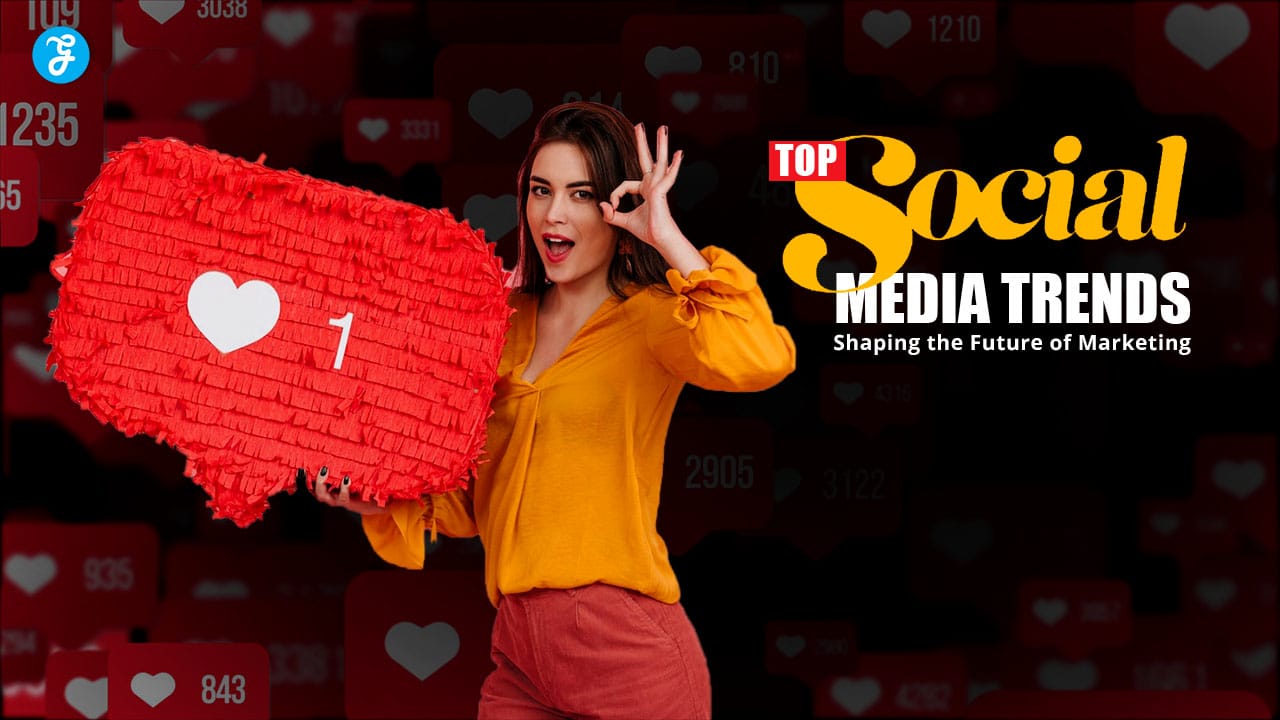Social media has evolved from a simple tool for personal connection into a powerful marketing platform.
Today, businesses of all sizes use social media to reach their target audiences, create brand awareness, drive engagement, and generate leads. Social platforms such as Instagram, TikTok, and LinkedIn are now integral to modern marketing strategies.
They offer unprecedented opportunities for brands to connect with consumers directly and build relationships. However, the social media landscape is constantly changing, making it crucial for marketers to stay ahead of emerging trends to remain competitive.
This article aims to explore the 15 key social media trends shaping the future of marketing. By understanding and leveraging these trends, businesses can stay ahead of the curve and take full advantage of the opportunities presented by social media platforms.
15 Social Media Trends Shaping the Future of Marketing
Let’s take a look.
1. The Rise of Short-Form Video Content
Short-form video content has skyrocketed in popularity, with platforms like TikTok, Instagram Reels, and YouTube Shorts leading the way. This content format, typically under 60 seconds, is engaging, fast-paced, and designed to capture users’ attention quickly.
As consumers’ attention spans shorten, short-form video has become the preferred way for users to consume content.
How Brands Are Leveraging Short-Form Video?
Brands are using short-form video to showcase product launches, behind-the-scenes footage, and customer testimonials. This format allows companies to communicate their message in an engaging, bite-sized way that is easily shareable.
For businesses looking to capture attention, using humor, creativity, and concise messaging in short-form videos can help generate high engagement rates and build brand awareness.
2. Growth of Influencer Marketing and Micro-Influencers
Influencer marketing continues to grow, with brands partnering with influencers to promote their products and services authentically. Influencers, who have built trust with their followers, provide a personal connection to brands that traditional advertising lacks.
Their recommendations often feel more credible than those from the brands themselves, which is why influencer marketing has proven to be effective.
The Rise of Micro-Influencers
Micro-influencers, who typically have smaller followings (10,000 to 100,000 followers), are gaining traction. Unlike macro-influencers with millions of followers, micro-influencers often have highly engaged and loyal audiences.
Brands are increasingly working with micro-influencers to target niche markets and foster more genuine connections, often at a lower cost than working with high-profile influencers.
3. Social Commerce and Shoppable Posts
Social commerce is the integration of e-commerce features within social media platforms, allowing users to make purchases directly through apps like Instagram, Facebook, and Pinterest.
This seamless shopping experience is revolutionizing the way consumers discover and buy products. The convenience of in-app purchases is reducing friction in the customer journey, which is contributing to the rapid growth of social commerce.
Leveraging Shoppable Posts for Seamless Customer Journeys
Brands can leverage shoppable posts to offer a more convenient and efficient buying process. By tagging products directly in posts and stories, users can shop without leaving the platform.
This allows for instant product discovery and encourages impulse purchases, ultimately boosting conversion rates. Brands that integrate social commerce into their marketing strategies are more likely to succeed in driving sales through social media.
4. Live Streaming for Authentic Engagement
Live streaming is gaining popularity as a tool for brands to engage with their audiences in real time. Whether it’s product demonstrations, Q&A sessions, or live events, live streaming offers a way for brands to interact directly with their customers and foster a sense of authenticity.
Live content is perceived as more raw and real, which resonates with audiences looking for genuine brand interactions.
Best Practices for Using Live Streaming in Marketing
Brands should promote live streams in advance to build anticipation and encourage viewers to join. During the stream, it’s essential to engage with the audience by responding to comments and answering questions in real time.
Following the event, businesses can repurpose the live content into clips or highlights to extend its lifespan and reach a wider audience.
5. Augmented Reality (AR) and Virtual Reality (VR) Experiences
Augmented Reality (AR) and Virtual Reality (VR) are transforming how brands connect with consumers by offering immersive experiences. AR, which overlays digital elements on the physical world, and VR, which provides entirely virtual experiences, are becoming increasingly popular tools in marketing campaigns.
These technologies allow consumers to interact with products and brands in a more engaging and memorable way.
How Brands Are Using AR and VR in Social Media Campaigns?
Brands like Sephora and IKEA are using AR to allow customers to “try on” makeup or see how furniture fits in their homes. These interactive experiences are driving customer engagement and helping consumers make more informed purchasing decisions.
By incorporating AR and VR into their marketing strategies, businesses can create innovative and memorable experiences that stand out from the competition.
6. User-Generated Content (UGC) as a Trust-Building Tool
User-generated content (UGC) refers to any content—text, videos, images—created by consumers about a brand. Because UGC comes from real people rather than the brand itself, consumers highly trust it. It serves as a form of social proof, showing potential customers that others are enjoying and endorsing the brand’s products.
Encouraging UGC for Organic Growth
Brands can encourage UGC by creating hashtag campaigns, contests, or simply asking customers to share their experiences on social media.
Highlighting UGC in marketing campaigns or on social media feeds not only builds authenticity but also fosters a sense of community around the brand. UGC also helps brands create content at a lower cost and with less effort than producing content in-house.
7. Social Media as a Customer Service Channel
As consumers spend more time on social media, they expect brands to provide customer service directly through these platforms. Whether it’s resolving an issue or answering a question, consumers want fast and efficient responses.
This shift has transformed social media from a marketing tool to a critical customer service channel.
Strategies for Delivering Stellar Customer Service on Social Media
Brands should have dedicated teams to manage customer service inquiries on social media. It’s important to monitor messages and comments regularly to ensure timely responses.
Brands that offer quick, helpful, and friendly service on social media can turn customer interactions into positive experiences and build long-term loyalty.
8. The Emergence of Private Communities and Groups
Private groups on platforms like Facebook, LinkedIn, and Reddit are growing in popularity as brands create exclusive communities for their most loyal customers.
These groups offer a space for users to engage with the brand, share ideas, provide feedback, and connect with like-minded individuals. Private groups can foster a sense of belonging and strengthen relationships between the brand and its customers.
Building Engaged Communities for Brand Loyalty
Brands can use private groups to share exclusive content, offer special promotions, or gather feedback. By nurturing these communities, brands create deeper connections with their audience and cultivate brand advocates.
Engaged communities also provide valuable insights into customer preferences and behavior, which can inform future marketing strategies.
9. Ephemeral Content and the FOMO Factor
Ephemeral content, such as Instagram Stories and Snapchat posts, disappears after a short period, creating a sense of urgency for viewers to engage with it before it’s gone.
This content type is effective in leveraging the “fear of missing out” (FOMO) and encourages users to check back frequently for new content.
Using Ephemeral Content for Authentic Brand Engagement
Ephemeral content allows brands to share more casual, behind-the-scenes, or time-sensitive updates without cluttering their permanent feeds. It creates an opportunity for brands to experiment with storytelling and promotions in a low-risk way. This type of content is also highly engaging, as users are more likely to interact with it before it disappears.
10. Increased Focus on Social Responsibility and Purpose-Driven Marketing
Consumers are increasingly looking for brands that align with their values, especially around issues like sustainability, social justice, and ethical practices. Social responsibility is no longer just a buzzword—it’s a key factor in purchasing decisions.
Brands that demonstrate a commitment to making a positive impact are more likely to attract loyal customers.
Integrating Social Responsibility into Social Media Marketing
Brands should align their social media campaigns with causes that reflect their values and resonate with their target audience. Whether it’s supporting environmental initiatives or promoting inclusivity, purpose-driven marketing shows consumers that a brand stands for more than just profits.
Transparency is key—brands need to back up their social responsibility efforts with real actions.
11. The Use of Artificial Intelligence (AI) in Social Media Marketing
Artificial intelligence (AI) is revolutionizing social media marketing by enabling brands to deliver personalized content, automate responses, and optimize ad targeting. AI-powered tools like chatbots, recommendation engines, and sentiment analysis are helping marketers create more effective and efficient campaigns.
Leveraging AI for Smarter Marketing Campaigns
Brands can use AI to analyze customer data and deliver personalized recommendations based on user behavior and preferences. AI chatbots can handle customer service inquiries or even assist with product recommendations.
By automating these processes, brands can provide personalized experiences at scale, improving engagement and conversion rates.
12. The Impact of Voice Search on Social Media
With the rise of voice-activated devices like Amazon’s Alexa and Google Home, voice search is changing the way consumers find information online.
This trend is influencing social media marketing, as brands need to optimize their content for voice search to remain discoverable.
Adapting Social Media Strategies for Voice Search Optimization
To optimize for voice search, brands should focus on creating conversational content that answers common questions. Including natural language keywords and ensuring content is mobile-friendly are also important for voice search optimization.
As voice search continues to grow, integrating it into social media marketing strategies will become essential for improving discoverability.
13. The Shift Toward Micro and Nano-Targeting
Micro-targeting allows brands to reach highly specific segments of their audience with tailored messages.
Social media platforms offer detailed targeting options based on demographics, interests, behaviors, and even life events, allowing brands to deliver personalized content to the right audience at the right time.
Leveraging Micro-Targeting for Maximum ROI
Brands can use social media advertising tools like Facebook Ads and LinkedIn Ads to create custom audience segments and deliver highly personalized content. Micro-targeting helps improve return on investment (ROI) by reaching users who are more likely to engage with the content and convert into customers. ‘
This approach ensures that marketing budgets are spent efficiently.
14. Cross-Platform Strategies for Consistent Brand Messaging
As brands expand their presence across multiple social media platforms, maintaining a consistent brand message is crucial for building trust and recognition.
While each platform may require different content formats or tones, the overall messaging should align with the brand’s values, goals, and voice.
Developing Cross-Platform Social Media Campaigns
To create a consistent cross-platform strategy, brands should define a unified voice and visual identity that can be adapted to different platforms. For example, a brand’s tone on LinkedIn may be more professional, while it can be more playful on Instagram.
However, the core messaging should remain the same. Brands that master this consistency can build strong brand recognition and loyalty.
15. Data Privacy and Ethical Marketing Practices
With increasing awareness of data privacy concerns, consumers are becoming more cautious about how their information is collected and used.
Social media platforms have come under scrutiny for their data collection practices, leading to stricter regulations like the General Data Protection Regulation (GDPR) and the California Consumer Privacy Act (CCPA).
Building Trust Through Ethical Marketing
To build trust with consumers, brands must prioritize transparency in how they collect, store, and use personal data. Being upfront about data usage and adhering to privacy regulations not only protects consumers but also fosters trust and credibility.
Ethical marketing practices that prioritize consumer privacy will become increasingly important as data privacy concerns continue to grow.
Conclusion
As social media continues to evolve, marketers must stay up-to-date with the latest trends to remain competitive. By embracing these 15 trends—from short-form video and influencer marketing to social commerce and AI—brands can create more engaging and effective social media strategies.
The future of marketing lies in personalization, authenticity, and innovation, and these trends will shape the way businesses connect with their audiences.
Success in social media marketing requires adaptability and a willingness to experiment with new trends and technologies.
By integrating these trends into your marketing strategy, you can build stronger connections with your audience, enhance brand loyalty, and achieve long-term growth in the digital landscape.








































